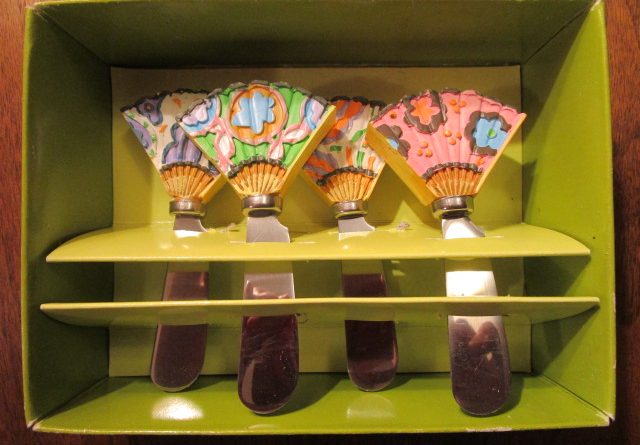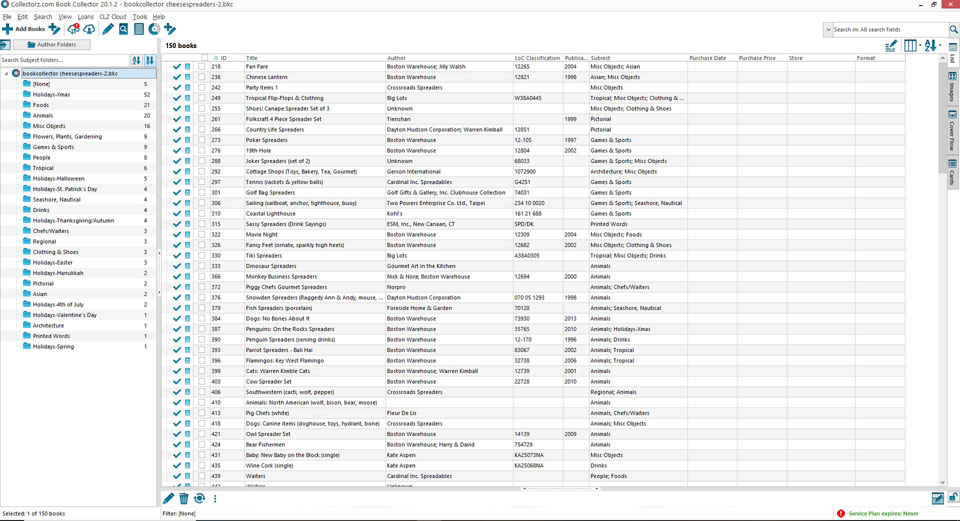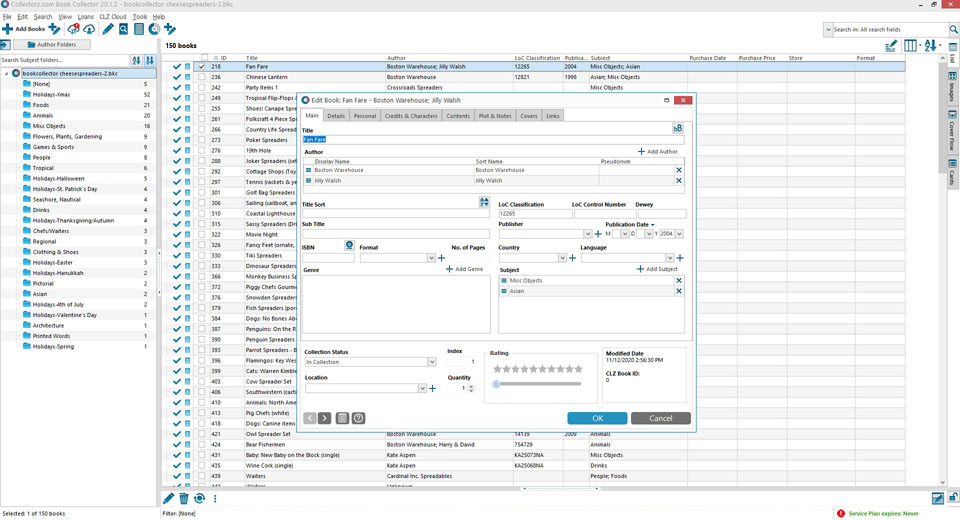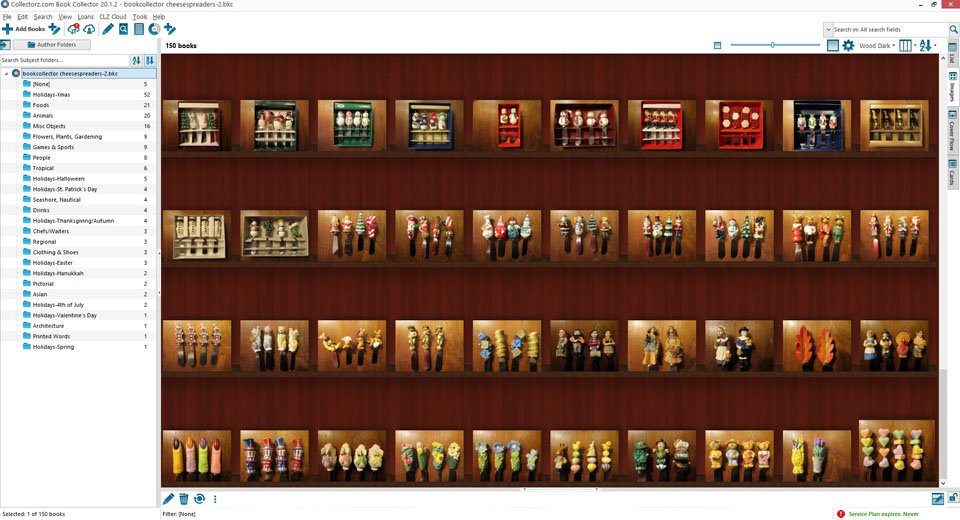Still collecting… and finally, cataloging!
Above: one of my recent acquisitions, a set of four Chinese fans, “Fan Fare,” designed by Boston artist Jilly Walsh for Boston Warehouse (2004).
Greetings after a long hiatus! I haven’t posted here on my Cheese Spreader Blog for more than five years. But I’m still collecting cheese spreaders, and my enthusiasm for them hasn’t decreased, although it has waxed and waned through this period.
During these past five years, the decline in popularity of resin-handled cheese spreaders has continued, as it had been doing for the past decade before that. Resin-handled cheese spreaders, usually sold in sets of four or sometimes with themed “spreader houses” to hold them, reached their height of popularity during the late 1990s, but they have been falling from public favor since around 2005. Boston Warehouse, the originator of these items to my knowledge, no longer makes them, although they occasionally offer a ceramic spreader in a more modern design. Amazon sells a few new ones, and a couple of other companies still manufacture them, but they are not nearly so widely available as in past days.
Even in thrift stores, they do not appear with nearly such frequency as they did a decade ago. (I imagine that most people have already gotten rid of the ones they bought back in the ’90s and early aughts, although occasionally a set appears in a local resale shop, perhaps for the second- or third-time thrift store resale.)
The big market for purchasing spreaders is now online (as with so many other things). Ebay, Etsy, Poshmark, Mercari: these are the places to look for them. And this holds doubly true during this year of the Covid pandemic. I troll Ebay and those other websites every so often, and my collection has continued to slowly increase over the past five years.
But looking on the bright side of their decline in popularity: because cheese spreader sets are currently underappreciated, they are also affordable to purchase compared to other collectors’ items. True, shipping often doubles their price online, but there is a huge selection available — I often feel like a kid in a candy shop when I’m looking on Ebay, and must limit my purchases (although I greatly enjoy looking at them, just to see all the different kinds, even when I don’t buy a set).
Cataloguing
During the past couple of weeks, I’ve been working on a project that I’ve meant to do for years: cataloging my cheese spreader collection. I know this sounds like a ridiculous waste of time, but I can’t tell you how many times I’ve bought the same common spreader sets when I’m at a thrift store, because I can’t remember whether I already have them.
And I’d also like an easy way to look up which sets I have while sitting at my computer, as I do most of my spreader shopping online now, and it’s easier not to have to go physically sort through the boxes of the ones in my collection.
Also, I’d really like to know just how many cheese spreaders I actually have, since I’ve never counted them (there’s a lot of them, suffice it to say).
I dithered for years over the best way to do this, whether I should use cataloging software, or whether an Excel spreadsheet would be simpler. But in the end I decided to use the same software that I have used for decades to catalog my book collection: Book Collectorz.
Here’s a screenshot of the list view of the Collectorz software:
To enter a new set, I clicked the little “Plus” sign with a pen next to it, to manually enter a set (if it was a book, I could simply enter the ISBN code to look it up automatically online instead).
Here’s the box in which I entered the listing for the “Fan Fare” spreader set, shown in the first picture:
Each listing (each “book” in the Book Collectorz software) has a title that will help me know which ones I have, as well as an “author” (the manufacturer and/or designer, such as Boston Warehouse), and a subject category (such as Animals, Foods, specific holidays, etc.).
But the coolest part is that I can insert a photo of the set into the listing, under “Covers” (just like a book cover image). And then I can see a display of all the images, like this:
This makes it very easy to see which sets I already have in my collection. Plus, I can print out pages of thumbnail images like above, and send the printout to my mother, who is a regular Goodwill shopper who always keeps her eyes peeled for more spreaders for my collection — that way, she’ll know which ones I already have.
I’m finally finished photographing and adding my spreaders to my catalogue — it’s great to finally have this done, and it’s really good to go through all of my spreaders. I have removed some duplicates, plus I’ve found sets that I forgot I even had!
So how many do I have? Well, I entered more than 260 sets, mostly with four spreaders per set, so that’s more than a thousand individual spreaders! And I didn’t even enter all of the miscellaneous single spreaders that I’ve picked up over the years, ones that are missing the rest of the spreaders in the set — I’m sure there are at least 50-100 of those. That’s a lot of spreaders — no wonder I forget which ones I have!
But now I can easily check which ones I have before buying new ones — this was a good thing to get done during a pandemic stay-at-home week.
My Pinterest “Collection”
Another thing that I have recently begun doing is to collect images of interesting looking cheese spreaders on Pinterest: https://www.pinterest.com/bethinIowa1457/_saved/
The Pinterest image collection satisfies my urge to collect cheese spreaders, but at a much lower cost than actually purchasing them (it should be totally free, but I often end up buying a set that I find through Pinterest). And I find many images of sets that are not currently available anywhere online which I could not purchase even if I wanted to pay for them, but I can still “collect” the image. (There are other Pinterest members who have image collections of cheese spreaders on Pinterest too, so it’s not just me who likes them, BTW.) 🙂
My next project may be to try to get an idea of just how many spreader sets are out there to collect. It might not even be possible to get an idea of how many there are, but it could be fun to continue looking around online — since our pandemic stay-at-home period might just be beginning at the start of a long winter….
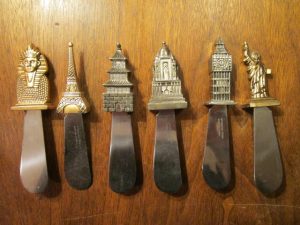 |
| The sheer variety of spreaders out there is mind-boggling. Here’s a set of all-metal world landmarks spreaders in my collection. |
Anyway, that’s what I’ve been up to regarding my cheese spreader collection for the past five years — and I hope to post here a few more times in coming months, and not wait quite such a long time until the next post!
Thank you to anyone who might be reading this — if you are a fellow collector out there, you are not alone in your enthusiasm for these surprisingly clever, currently underappreciated items.

